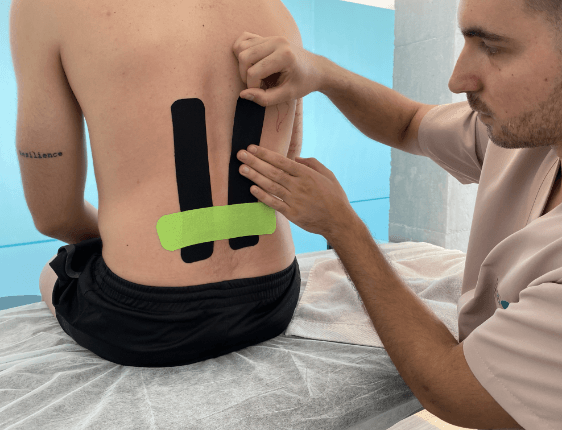
Japanese Technique That Acts on the Musculoskeletal and Lymphatic System
Kinesiotaping, also known as neuromuscular taping, is a Japanese taping technique that acts on the musculoskeletal and lymphatic system. It was developed by Dr Kenzo Kase and involves applying adhesive tapes to the affected area. These tapes are elastic, allowing them to adapt to the skin’s natural movement. You have probably seen them on people in the street and wondered: what are they for? Keep reading, and we will explain everything.
Thanks to the tape’s unique properties, the bandaged area can move freely, unlike traditional bandages. Kinesiotaping is highly effective in relieving pain and treating muscle injuries, as reported by numerous athletes and patients who have used it over time.
Initially, it was used by orthopaedists, chiropractors, acupuncturists, and other professionals in Japan. Today, it has spread worldwide due to its proven success in the sports industry. Many athletes have shared how neuromuscular taping has positively impacted their athletic performance.
A description of neuromuscular bandage.
The tape is usually made of an elastic cotton bandage that can be stretched up to 140% of its original length. This tape, as has been demonstrated in practice, successfully corrects the alignment of weak muscles and facilitates joint movement, thanks to the traction qualities of the bandage itself.
This tape must be applied over the stretching muscle, from the origin point of the muscle to its point of insertion. Once applied, the tape is then rubbed, in order to activate the adhesive.
Neuromuscular tape is typically applied in three general shapes: the “I” shape, for small or linear places; the “Y” shape, for larger muscles such as the deltoid; and the “X” shape, for large and long muscles, such as the quadriceps.
Its analgesic properties are also being studied: according to what we have experienced with some of our patients, neuromuscular taping may help reduce inflammation and optimize mobility. This will provide the patient with greater performance and stability when practicing sports and in their daily routines.

Neuromuscular Taping Success Stories: From Armstrong to Serena Williams
Neuromuscular taping, an elastic bandage used to treat various dysfunctions, gained wide popularity at the 2008 Beijing Olympics. Kerri Walsh was one of the athletes to appear with the tape in competition, but not the only one. Lance Armstrong, for his part, has repeatedly described the numerous benefits of neuromuscular taping. Other athletes, such as Serena Williams, Buffon, Mario Ballotelli, and Djokovic, have expressed their satisfaction with the results of this type of bandage.
One of the best known cases is that of WWE wrestler John Cena, who used the tape to reduce pain and eliminate inflammation after undergoing an operation to remove bone chips from his elbow.
Indications for neuromuscular taping:
- Reduce inflammation
- Pain relief
- Reduce bruising
- Joint correction
- Improved proprioception
- Fascia correction
- Stimulation of hypotonic muscles
- Inhibition of hypertonic muscles
Frequently asked questions about neuromuscular taping - FAQs
What are the benefits of muscle taping?
The benefits include pain relief, reduced inflammation, improved circulation, muscle and joint support, and facilitation of the body’s natural healing process. Additionally, it allows for maintained mobility, which is essential for functional recovery.
What types of injuries is muscle taping recommended for?
It is recommended for muscle injuries, sprains, tendinitis, joint pain, muscle overuse, and postural correction. It is also useful for injury prevention during sports activities.
Does the colour of the tape affect its effectiveness?
No, the colour of the tape is mainly aesthetic and does not influence its functionality. The choice of colour is based on personal preference or psychological considerations but does not alter the therapeutic effects of the tape.
How long can muscle tape be worn?
Generally, the tape can remain in place for between 3 and 7 days, depending on the application area, skin type, and physical activity. It is water-resistant, allowing for showering or swimming without issues.
Can anyone apply muscle tape by themselves?
Although the tape is easy to use, it is recommended that it be applied by a trained healthcare professional. Incorrect application may not provide the desired benefits and could even worsen the injury.
Are there any contraindications for using muscle tape?
Yes, it should not be applied to open wounds, burns, irritated skin, or individuals allergic to adhesives. It is also not recommended in cases of thrombosis, skin infections, or during pregnancy without medical supervision.
Is muscle taping effective on its own, or should it be combined with other treatments?
Muscle taping is a complementary tool and is usually more effective when combined with other therapeutic interventions, such as rehabilitation exercises, manual therapy, and physiotherapy, as advised by a healthcare professional.
